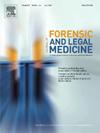Sex estimation from the variables of talocrural joint by using machine learning algorithms
IF 1.2
4区 医学
Q3 MEDICINE, LEGAL
引用次数: 0
Abstract
This study has focused on sex determination from the variables estimated on X-ray images of the talocrural joint by using machine learning algorithms (ML). The variables of the mediolateral diameter of tibia (TMLD) and fibula (FMLD), the distance between the innermost points of the talocrural joint (DIT), the distance between the outermost points of the talocrural joint (DOT), and the distal articular surface of the tibia (TAS) estimated using X-ray images of 150 women and 150 men were evaluated by applying different ML methods. Logistic regression classifier, Decision Tree classifier, K-Nearest Neighbor classifier, Linear Discriminant Analysis, Naive Bayes and Random Forest classifier were used as algorithms. As a result of ML, an accuracy between 82 and 92 % was found. The highest rate of accuracy was achieved with RFC algorithm. DOT was the variable which contributed to the model at highest degree. Except for the variables of the age and FMLD, the other variables were found to be statistically significant in terms of sex difference. It was found that the variables of the talocrural joint were classified with high accuracy in terms of sex. In addition, morphometric data were found about the population and racial differences were emphasized.
利用机器学习算法从talocrural joint的变量进行性别估计
本研究的重点是通过使用机器学习算法(ML)从距骨关节x射线图像估计的变量中确定性别。采用不同的ML方法对150例女性和150例男性的x线图像估计的胫骨内外侧直径(TMLD)和腓骨内外侧直径(FMLD)、距骨外侧关节最内点之间的距离(DIT)、距骨外侧关节最外点之间的距离(DOT)和胫骨远端关节面(TAS)等变量进行了评估。采用逻辑回归分类器、决策树分类器、k近邻分类器、线性判别分析、朴素贝叶斯和随机森林分类器。作为ML的结果,发现准确率在82 - 92%之间。RFC算法的准确率最高。DOT是对模型贡献最大的变量。除年龄和FMLD变量外,其他变量的性别差异均有统计学意义。发现距骨关节的变量在性别方面分类具有很高的准确性。此外,还发现了种群和种族差异的形态计量数据。
本文章由计算机程序翻译,如有差异,请以英文原文为准。
求助全文
约1分钟内获得全文
求助全文
来源期刊

Journal of forensic and legal medicine
MEDICINE, LEGAL-
CiteScore
2.70
自引率
6.70%
发文量
106
审稿时长
57 days
期刊介绍:
The Journal of Forensic and Legal Medicine publishes topical articles on aspects of forensic and legal medicine. Specifically the Journal supports research that explores the medical principles of care and forensic assessment of individuals, whether adult or child, in contact with the judicial system. It is a fully peer-review hybrid journal with a broad international perspective.
The Journal accepts submissions of original research, review articles, and pertinent case studies, editorials, and commentaries in relevant areas of Forensic and Legal Medicine, Context of Practice, and Education and Training.
The Journal adheres to strict publication ethical guidelines, and actively supports a culture of inclusive and representative publication.
 求助内容:
求助内容: 应助结果提醒方式:
应助结果提醒方式:


